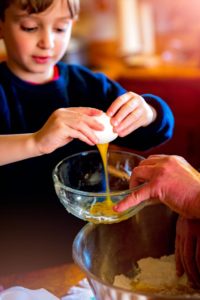Cooking with Your Kids Part 1 – Speech Perspective
 Some of my earliest childhood memories include helping my mom and dad in the kitchen. From a young age, I was standing on a stool at the stove stirring spaghetti sauce or moving hot dogs around a frying pan with a fork. Cooking with your kids and involving them in food prep is a great way to teach sequencing and increase independence. It can also expand language and encourage an interest in a variety of food, just to name a few! This is especially helpful if you have a picky eater (or eaters) on hand. I know you’re probably thinking the kitchen can be a pretty dangerous place. But, there is probably something your child could help with during every meal. This is especially true if you don’t mind a little mess here or there.
Some of my earliest childhood memories include helping my mom and dad in the kitchen. From a young age, I was standing on a stool at the stove stirring spaghetti sauce or moving hot dogs around a frying pan with a fork. Cooking with your kids and involving them in food prep is a great way to teach sequencing and increase independence. It can also expand language and encourage an interest in a variety of food, just to name a few! This is especially helpful if you have a picky eater (or eaters) on hand. I know you’re probably thinking the kitchen can be a pretty dangerous place. But, there is probably something your child could help with during every meal. This is especially true if you don’t mind a little mess here or there.
What Can Kids Do in the Kitchen?
Children as young as two can make great kitchen helpers. Are you making scrambled eggs for breakfast? They can help crack the egg with your hand over theirs to help with force and control. They can even help pick the eggshells out of the bowl, if necessary. Adding any cheese or veggies to the eggs? You chop, and your toddler can scoop the cheese or add-ins with their hands into the bowl or into a measuring cup to dump. They are also great at helping to stir! Most meal prep can be modified in some way to allow your child to help in an age appropriate way. As children get older, they can begin helping even more and can learn more advanced skills such as safe cutting/chopping, measuring, and using the stove or other appliances.
Some easy meal and snack ideas you can try when cooking with your kids (or teach them to make independently) include: making tuna fish, peanut butter and banana roll ups, grilled cheese, and no bake cookies.
How to Encourage Language When Cooking with Your Kids
When you have your kids help out making breakfast, lunch, or dinner, it’s also a great time to talk about and try the ingredients. If you are cooking with unfamiliar foods, you can talk about what they think a food might taste like. You can also talk about what foods feel like (smooth, bumpy, soft, etc.), look like, and smell like. This is a great time to help teach descriptive vocabulary too. For example, if cooking with a familiar food that your child likes and you ask, “What does it smell like?” They may respond with, “good.” Then you can give choices like, “Does it smell sweet like a marshmallow or smokey like a hamburger,” etc.
But What if My Child is a Picky Eater?
Cooking or helping with meal prep may even encourage your child to try foods they have previously resisted. Seeing individual ingredients and how things are made may make trying a new food less scary or intimidating. Meal prep may be a less stressful way for pickier eaters to interact with food without the pressure to eat it. If you have a very picky eater and you are concerned that it may not be normal, you can find more information in our Picky Eater or Problem Feeder article. Reaching out to a pediatric occupational or speech therapist may also help to provide guidance.
